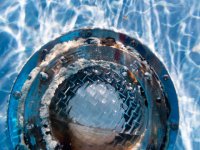- Oct 19, 2018
- 10
- Pool Size
- 24000
- Surface
- Vinyl
- Chlorine
- Salt Water Generator
- SWG Type
- Hayward Aqua Rite (T-15)
About two years ago, I had my pool light replaced, and a new stainless steel light and ring installed. Since then I've noticed a steady corrosion of the steel (see photo). I had requested a marine grade (314) ring, but I think the Pentair that was actually installed is only 304.
During this time, I've closely monitored my pool chemistries with with the amazing help of this forum and its TFP calculators, maintaining the ranges below. I've used a polyquat algicide for closing, but otherwise have avoided using other pool store chemicals. The pool is regularly scrubbed despite the foul-looking deposits that seem to grow on this light & ring.
Has anybody else had this sort of issue with stainless steel light ring in a salt water pool?
Any suggestions to remedy this situation would be greatly appreciated.
Pool Description: 24K gal vinyl lined pool with SWG
Free chlorine levels: 5.0 to 8.0
CyA: 60-80
pH: 7.8-8.0
Total Alkalinity: 200
Calcium: 225
NaCl: 3000-3400
During this time, I've closely monitored my pool chemistries with with the amazing help of this forum and its TFP calculators, maintaining the ranges below. I've used a polyquat algicide for closing, but otherwise have avoided using other pool store chemicals. The pool is regularly scrubbed despite the foul-looking deposits that seem to grow on this light & ring.
Has anybody else had this sort of issue with stainless steel light ring in a salt water pool?
Any suggestions to remedy this situation would be greatly appreciated.
Pool Description: 24K gal vinyl lined pool with SWG
Free chlorine levels: 5.0 to 8.0
CyA: 60-80
pH: 7.8-8.0
Total Alkalinity: 200
Calcium: 225
NaCl: 3000-3400


